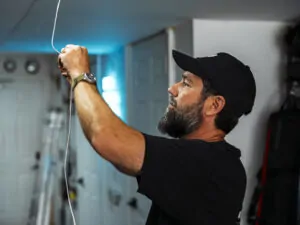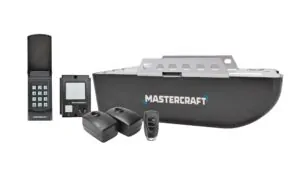This guide is designed to help you properly and efficiently install your garage door opener, ensuring smooth and reliable operation for years to come. Proper installation is crucial for maximizing the performance, safety, and lifespan of your garage door opener. With this guide, you’ll learn everything you need to know, from the tools required to the step-by-step process for a successful setup. To begin, make sure you have all the necessary tools and materials ready, and allocate adequate time to complete the installation safely and correctly.
If you are looking for professional Mastercraft Garage Door Opener Installation, call Motion Garage Doors today.
Pre-Installation: Check The Door
Before you mount the opener, here’s what to inspect:
- Confirm the garage door is balanced and not sticking or binding. The manual says: raise the door halfway — if it doesn’t stay, it’s unbalanced.
- Check clearance: If the door is over 7′ high, you’ll need a rail extension kit.
- Ensure the gap between the bottom of the door and the garage floor is no more than ¼″.
Pro tip: As you’re on‐site, mark these issues in your log or job sheet so you’re not installing an opener onto a deficient door system.
What the Kit Includes
Know what comes in the box so you’re ready for the install:
- Wall console, keychain remote, keyless entry pad.
- Safety beam sensors.
- Rail sections, chain & cable assembly, idler pulley, trolley assembly, door/head brackets, hardware bags.
- Important: If any part is missing or damaged, stop and reorder — you don’t want to improvise critical safety parts.
Step-by-Step Installation Overview
Here’s an annotated sequence for installation — it aligns with the Mastercraft manual but is framed for contractors.
1) Assemble the Rail
- Lay out the rail sections on the floor; align and slide the tapered ends together.
- Install the trolley assembly (note the arrow marking on the trolley, toward the door).
- Install idler pulley in the front rail section (to door) with spacers and clevis pin/hitch pin.
- Attach the sprocket assembly to the back rail section (toward the motor unit).
- Attach the entire rail assembly to the motor-unit: insert sprocket into motor shaft, secure with screws, attach rail.
- Install the chain: route through the front slot, engage idler pulley, wrap around sprocket, make sure it’s aligned.
- Tighten the chain via the turnbuckle (do not rotate the threaded shaft — you’ll twist the chain).
- After installation, check for chain “drop” when the door is closed — some slack is normal, but too much means noise or wear.
2) Install Header Bracket
- With the door closed, mark the vertical centreline of the door on the wall and its top panel.
- Mark a spot 1¼″ (3 cm) above the highest point of the door’s travel (sectional) or 7″ (18 cm) (one-piece).
- If the mark falls above the header and there’s no structural backing, attach a 2×4 between studs or joists before mounting bracket.
- Drill pilot holes and attach bracket with lag screws or concrete anchors (if mounting to masonry).
3) Hang the Opener Unit
- With the door fully open (parallel to the floor), raise the opener on the ladder or spacers to match the top of the opened door.
- Attach hanging brackets to structural support (joists or finished ceiling).
- Bolt the opener to the hanging brackets, centre the T-rail over the door. Remove the 2×4 that was used for positioning.
4) Install Door Bracket & Door Arms
- Mount the door bracket: for sectional doors it goes 2-4″ (5-10 cm) below the top edge of the door or under structural support.
- For one-piece doors, position the bracket centred on the top of door.
- Connect the curved/straight arm to the door bracket via clevis/hitch pins. Then connect the other arm to the trolley.
- Ensure the emergency release handle hangs 6′ (1.8 m) above the floor — check rope length.
5) Install Wall Console
- Mount the wall button/console at least 5′ (1.5 m) above finished floor or topmost step.
- Connect the bell-wire terminals (polarity not sensitive). Route wire neatly with holders across wall & ceiling.
- Mount the entrapment warning label adjacent to the console.
6) Connect to Power
- Plug into a grounded outlet. If no proper outlet exists, call a licensed electrician.
- If hard-wiring is required: remove power cord, remove cover, remove bushing, wire according to code: Green = Ground, White = Neutral, Black = Hot.
- Important: Never use an extension cord, adaptor, or alter the plug. Grounding is essential.
7) Install Safety Beam Sensors
- Install the transmitting (red LED) and receiving (blue LED) sensors. The receiving sensor must be ≤ 6″ (15 cm) above the floor.
- Mount one sensor on each track (or optional wall/floor mount). Use a block if needed for depth clearance.
- Route and secure wires, connect to terminals (polarity not sensitive).
- Plug opener in: The blue LED on the receiving sensor should glow steadily. If dim/flicker, adjust alignment. Test by breaking beam — door should stop or reverse.
8) Programming & Final Settings
- Set travel limits and force settings:
- With power connected, hold [SET] button until LED display shows “1”. Press p to open fully. Press [SET]. Display shows “2”. Press q to close fully. Press [SET]. LED flashes 3×.
- Motor then enters force-learning mode: open & close once fully so it figures out proper force.
- Program remote control: Press [SET] for 1 second (LED shows “P”). Within 30 s, press button on remote. LED off + one beep = success.
- Program keypad entry: Default PIN is “0000”. Follow steps to set new PIN; for multiple doors use “#1”, “#2” etc.
Safety & Quality Assurance
- After installation, always test the safety reversal: Place a 2 by 4 board under the door center when closing; the door must reverse.
- Also test the safety beam: With door open, break beam — close push should result in door moving ≤ 1″ (2.5 cm) then stopping or reversing.
- Make sure the manual release handle, emergency labels, entrapment labels are properly placed.
Maintenance & Longevity
- Monthly: Test door balance, observe full open/close, test reversal and beam.
- Every 6 months: Check chain tension — turnbuckle should be slightly above rail. Adjust as necessary.
- Annually: Oil rollers, bearings, hinges. Let the opener’s automatic force adjustment adapt itself — the opener monitors and sets opening/closing force automatically after you set travel limits.

If you are looking for professional Mastercraft Garage Door Opener Installation, call Motion Garage Doors today.







